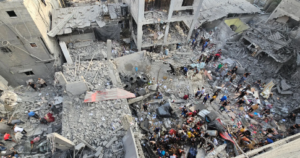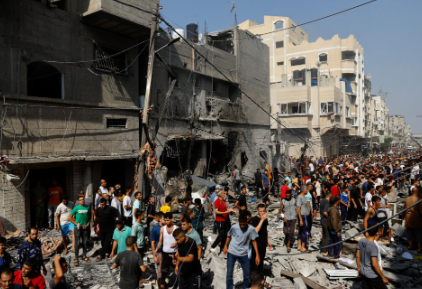SEO Keywords : Israeli airstrikes, Gaza safe zone, humanitarian zone, Khan Younis, civilian casualties, Hamas conflict, Gaza crisis, IDF military operation, international law, humanitarian impact, ceasefire, conflict escalation
Gaza City, September 9, 2024 — In a brutal escalation of the ongoing conflict, Israeli airstrikes have claimed the lives of at least 40 people and injured dozens more in southern Gaza. The strikes targeted the al-Mawasi area of Khan Younis, a designated humanitarian zone, according to the Hamas-run Civil Defence authority. This area had become a refuge for thousands of displaced Palestinians fleeing the ongoing Israeli military offensive.
The airstrikes, which occurred shortly after midnight, left the al-Mawasi area in ruins, with massive craters measuring up to seven meters deep. Eyewitnesses described the aftermath as catastrophic, with tents housing displaced families obliterated and survivors frantically digging through the rubble with their bare hands in desperate attempts to save lives.
Khaled Mahmoud, a volunteer with a local charity, recounted the horror he encountered when he arrived at the scene. “The strikes were so powerful that they created deep craters and buried more than 20 tents. The devastation is unimaginable,” Mahmoud said. “We could see flames rising into the night sky, and the cries of those trapped under the rubble were haunting.”
The Israel Defense Forces (IDF) have confirmed the strikes, stating they targeted a Hamas command and control center embedded within the humanitarian zone. The IDF emphasized that they took extensive precautions to avoid civilian casualties, including using precise munitions and conducting thorough aerial surveillance before the attack.
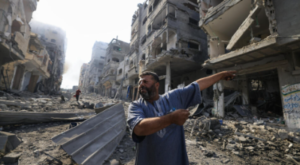
“Significant Hamas terrorists were operating within a command and control center in Khan Younis,” an IDF spokesperson declared. “Numerous steps were taken to mitigate the risk to civilians, but the terrorist organizations in Gaza continue to abuse civilian and humanitarian infrastructure for their operations.”
Hamas, however, vehemently denied the presence of its fighters in the area, calling the Israeli claims a “blatant lie.” A spokesperson for the group stated, “The resistance has repeatedly denied that any of its members are within civilian gatherings or using these places for military purposes. Israel’s justification for targeting this area is completely unfounded.”
The al-Mawasi area had been considered a relatively safe haven for the thousands of Palestinians displaced by the Israeli military campaign, which was launched in response to the unprecedented Hamas attack on southern Israel on October 7. That attack resulted in the deaths of approximately 1,200 Israelis and the capture of 251 hostages, triggering the latest round of hostilities.
Since the escalation began, the humanitarian crisis in Gaza has reached dire levels, with the death toll surpassing 40,900, according to the Hamas-run health ministry. The relentless airstrikes, combined with the ongoing blockade, have created what many are calling an “unprecedented catastrophe” in the densely populated enclave.
The international community has expressed growing concern over the rising civilian death toll and the widespread destruction in Gaza. Calls for a ceasefire have intensified, but prospects for peace remain elusive as both sides continue to exchange accusations and retaliatory strikes.
Human rights organizations have condemned the attack on the humanitarian zone, labeling it a potential violation of international law. “Targeting civilians and humanitarian zones is a grave breach of international humanitarian law,” said a representative from Human Rights Watch. “The loss of innocent lives in al-Mawasi is a tragedy that underscores the urgent need for accountability and a resolution to the conflict.”
As rescue operations continue in Khan Younis, the situation on the ground remains fluid, with fears of further escalation. The world watches closely as the humanitarian toll in Gaza mounts, raising urgent questions about the future of the region and the possibility of achieving lasting peace amidst the ongoing violence.
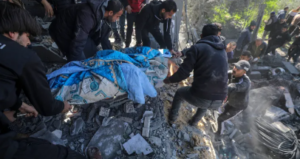
1. Historical Context
- Background on the Conflict: Provide a brief history of the Israel-Gaza conflict, highlighting key events leading up to the current escalation. Mention past ceasefires, peace talks, and significant military operations, such as Operation Protective Edge (2014) and Operation Guardian of the Walls (2021).
- Hamas’s Role: Discuss the role of Hamas in Gaza, its origins, and its designation as a terrorist organization by several countries, including Israel, the United States, and the European Union. Highlight the group’s governance of Gaza since 2007 and its impact on the region.
2. Humanitarian Impact
- Displacement Crisis: Detail the scale of displacement in Gaza, with thousands of Palestinians forced to flee their homes due to the ongoing military operations. Include statistics on the number of displaced individuals, the living conditions in temporary shelters, and the challenges faced by aid organizations in providing assistance.
- Casualty Figures: Expand on the casualty figures, breaking them down by civilians, women, children, and the elderly. Provide comparisons to previous conflicts to illustrate the severity of the current situation.
- Healthcare System Collapse: Discuss the strain on Gaza’s healthcare system, including hospitals’ inability to cope with the influx of wounded, shortages of medical supplies, and the impact of power outages and fuel shortages on life-saving services.
3. International Reactions
- Global Condemnation: Include statements from international leaders and organizations, such as the United Nations, the European Union, the United States, and neighboring Arab countries. Highlight calls for ceasefire, humanitarian access, and investigations into potential war crimes.
- Diplomatic Efforts: Detail ongoing diplomatic efforts to broker a ceasefire, including the roles of key mediators such as Egypt, Qatar, and the United States. Mention previous ceasefire agreements and their outcomes.
- Protests and Public Opinion: Report on global protests and public demonstrations in response to the conflict. Include details of rallies in major cities, public opinion polls, and the impact on diaspora communities.
4. Military and Strategic Analysis
- Israeli Military Strategy: Analyze the strategic objectives of the Israeli military campaign, including the targeting of Hamas infrastructure, the use of precision airstrikes, and the challenges of urban warfare in densely populated areas.
- Hamas Tactics: Discuss Hamas’s military tactics, including the use of tunnels, rocket attacks on Israeli cities, and their impact on civilian life in both Gaza and Israel. Include statistics on the number of rockets fired and the effectiveness of Israel’s Iron Dome missile defense system.
5. Economic Impact
Economic Devastation in Gaza: Explore the economic impact of the conflict on Gaza, including damage to infrastructure, loss of livelihoods, and the broader economic blockade imposed by Israel and Egypt. Provide data on unemployment rates, poverty levels, and the challenges of rebuilding after the conflict.
- Cost of War: Discuss the financial cost of the military operations for Israel, including defense spending, compensation for damages, and the economic impact on border communities. Mention any economic sanctions or boycotts imposed on Israel as a result of the conflict.
- 6. Future Prospects
- Peace Prospects: Offer an analysis of the prospects for peace in the wake of the conflict. Discuss potential scenarios, including a return to the status quo, the possibility of international intervention, and the long-term implications for Israeli-Palestinian relations.
- Long-term Consequences: Consider the long-term humanitarian, political, and social consequences of the conflict for both Israelis and Palestinians. Discuss the potential for radicalization, shifts in public opinion, and the impact on future generations.
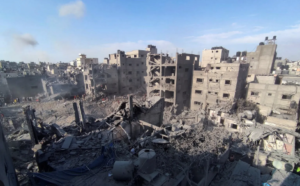
7. Eyewitness Accounts and Personal Stories
- Survivor Stories: Include more firsthand accounts from survivors, rescue workers, and medical personnel on the ground. Personal stories can humanize the conflict and provide powerful insights into the suffering experienced by civilians.
- Photographic Evidence: If possible, integrate descriptions of images or videos showing the aftermath of the strikes, the efforts of rescue teams, and the conditions in temporary shelters. Visual evidence can enhance the article’s impact and provide a more vivid portrayal of the situation.
8. Related Articles and Resources
- Links to Related Content: Include links to related articles, such as detailed reports on previous conflicts, profiles of key figures in the conflict, and analyses of the geopolitical implications of the Israeli-Palestinian struggle.
- Resource Guides: Offer readers additional resources for understanding the conflict, such as timelines, maps, and expert analyses. Consider creating a section for FAQs or common misconceptions about the conflict to educate readers.
9. Calls to Action
- Humanitarian Appeals: Highlight ongoing humanitarian appeals by organizations like the Red Cross, UNICEF, and UNRWA. Encourage readers to support relief efforts through donations or by raising awareness.
- Advocacy and Solidarity: Suggest ways readers can engage with the issue, such as participating in advocacy campaigns, contacting their representatives, or attending educational events and discussions.
